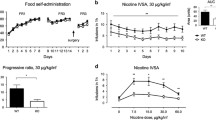Abstract
NICOTINE affects many aspects of behaviour including learning and memory1,2 through its interaction with neuronal nicotinic acetylcholine receptors (nAChR). Functional nAChRs are pentameric proteins containing at least one type of a-subunit and one type of p-subunit3–5. The involvement of a particular neuronal nicotinic subunit in pharmacology and behaviour was examined using gene targeting to mutate β2, the most widely expressed nAChR subunit in the central nervous system6–8. We report here that high-affinity binding sites for nicotine are absent from the brains of mice homozygous for the β2-subunit mutation. Further, electrophysiological recording from brain slices reveals that thalamic neurons from these mice do not respond to nicotine application. Finally, behav- ioural tests demonstrate that nicotine no longer augments the performance of β2-/-mice on passive avoidance, a test of associative memory. Paradoxically, mutant mice are able to perform better than their non-mutant siblings on this task.
Similar content being viewed by others
References
Flicker, C., Dean, R. L., Watkins, D. L., Fisher, S. K. & Bartus, R. T. Pharmac. Biochem. Behav. 18, 973–981 (1983).
Levin, E. D. Psycbopharmacology 108, 417–431 (1992).
Sargent, P. B. A. Rev. Neurosci. 16, 403–443 (1993).
Galzi, J.-L., Revah, F., Bessis, A. & Changeux, J.-P. A. Rev. Pharm. 31, 37–72 (1991).
Anand, R., Conroy, W. G., Schoepfer, R., Whiting, P. & Lindstrom, J. J. biol. Chem. 266, 11192–11198 (1991).
Wada, E. et al. J. comp. Neurol. 284, 314–335 (1989).
Hill, J. A. J., Zoli, M., Bourgeois, J.-P. & Changeux, J.-P. J. Neurosci. 13, 1551–1568 (1993).
Zoli, M., Le Novère, N., Hill, J. A. J. & Changeux, J.-P. J. Neurosci. (in the press).
Swanson, L. W. et al. Proc. natn. Acad Sci. U.S.A. 80, 4532–4536 (1983).
Flores, C. M., Rogers, S. W., Pabreza, L. A., Wolfe, B. B. & Kellar, K. J. Molec. Pharm. 41, 31–37 (1992).
Luetje, C. W. & Patrick, J. J. Neurosci. 11, 837–845 (1991).
Romano, C. & Goldstein, A. Science 210, 647–650 (1980).
Marks, M. J. & Collins, A. C. Molec. Pharm. 22, 554–564 (1982).
Marks, M. J. et al. J. Neurosci. 12, 2765–2784 (1982).
Decker, M. W. et al. J. pharmacol. exp. Ther. 270, 319–328 (1994).
Morris, R. G. M. J. Neurosci. 9, 3040–3057 (1989).
Silva, A. J., Paylor, R., Wehner, J. M. & Tonegawa, S. Science 257, 206–211 (1992).
Faiman, C. P., de Erausquin, G. A. & Baratti, C. M. Behavl Neural Biol. 56, 183–199 (1991).
Nordberg, A. & Bergh, C. Acta Pharm. Toxicol. 56, 337–341 (1985).
Merio Pich, E. & Samanin, R. Pharm. Res. 21, 595–602 (1989).
Crawley, J. N. Neurosci. biobehav. Rev. 9, 37–44 (1985).
Oliverio, A. J. pharmacol. exp. Ther. 154, 350–356 (1966).
Le Mouellic, H., Lallemand, Y. & Brulet, P. Cell 69, 251–264 (1992).
Yagi, T. et al. Proc. natn. Acad. Sci. U.S.A. 87, 9918–9922 (1990).
Magin, T. M., McWhir, J. & Melton, D. W. Nucleic Acids Res. 20, 3795–3796 (1992).
Selfridge, J., Pow, A. M., McWhir, J., Magin, T. M. & Melton, D. W. Somat. Cell molec. Genet. 18, 325–336 (1992).
Sambrook, J., Fritsch, E. F. & Maniatis, T. Molecular Cloning; A Laboratory Manual (Cold Spring Harbor Laboratory Press, New York, 1989).
Clarke, P., Shwartz, R. D., Paul, S. M., Pert, C. B. & Pert, A. J. Neurosci. 5, 1307–1313 (1985).
Author information
Authors and Affiliations
Rights and permissions
About this article
Cite this article
Picciotto, M., Zoli, M., Léna, C. et al. Abnormal avoidance learning in mice lacking functional high-affinity nicotine receptor in the brain. Nature 374, 65–67 (1995). https://doi.org/10.1038/374065a0
Received:
Accepted:
Issue Date:
DOI: https://doi.org/10.1038/374065a0
- Springer Nature Limited
This article is cited by
-
Levo-tetrahydropalmatine inhibits α4β2 nicotinic receptor response to nicotine in cultured SH-EP1 cells
Acta Pharmacologica Sinica (2022)
-
NACHO and 14-3-3 promote expression of distinct subunit stoichiometries of the α4β2 acetylcholine receptor
Cellular and Molecular Life Sciences (2021)
-
Potentiation of a neuronal nicotinic receptor via pseudo-agonist site
Cellular and Molecular Life Sciences (2019)
-
Stress-induced brain activation: buffering role of social behavior and neuronal nicotinic receptors
Brain Structure and Function (2018)
-
The Cholinergic System as a Treatment Target for Opioid Use Disorder
CNS Drugs (2018)





